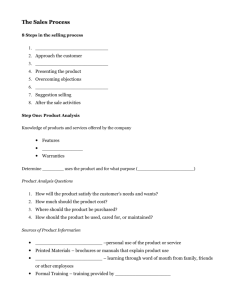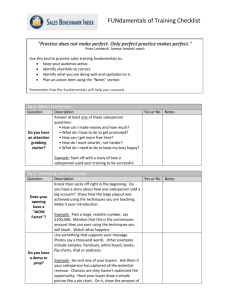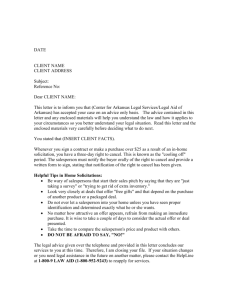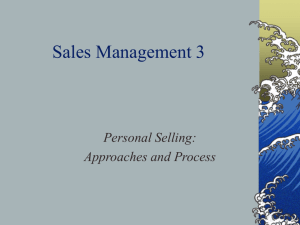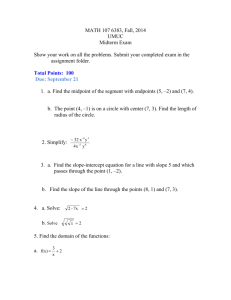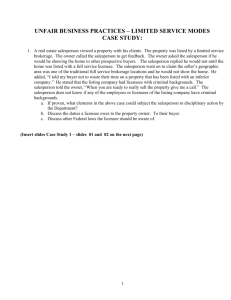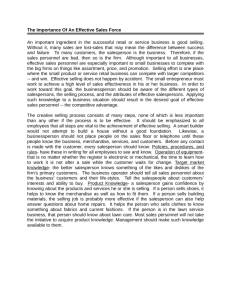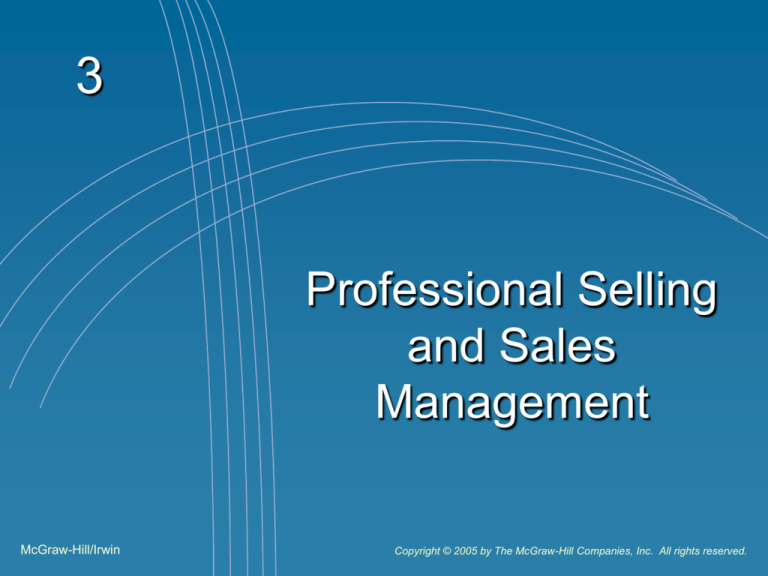
3
Professional Selling
and Sales
Management
McGraw-Hill/Irwin
Copyright © 2005 by The McGraw-Hill Companies, Inc. All rights reserved.
Agenda
How Professional Business Selling Differs
from Selling to Consumers
Profile of a Professional Salesperson
The Cost of Professional Selling
Understanding Buyer Behavior: A Seller's
Perspective
The Professional Selling Process
3-2
How Professional Business Selling
Differs from Selling to Consumers
Personal selling persuasive, deliberate
contact between a buyer and a seller for the
specific purpose of creating an exchange
between them.
Selling to consumers personal selling is
used to complement other elements in the
promotional mix.
Selling to business customers
professional selling is usually the primary
means of selling business goods and services.
3-3
Profile of a Professional Salesperson
Classifying sales jobs
Development-oriented
a.k.a. order-getting
Refers to the creation of customers
Missionary-oriented
Provide necessary professional selling
assistance
Do not intend to sell anything
3-4
Profile of a Professional Salesperson
Classifying sales jobs
• Maintenance-oriented
Involves the continuation of present sales
volume from existing customers
• Support-oriented
Provide continuing service to the buyer
May engage in some direct selling by
suggesting a replacement item rather than
a repair
3-5
Profile of a Professional Salesperson
One day’s work
• Averages 9 ½ + hours
• Less than 30 percent spent in face-to-face
selling
• About 30 percent in travel and waiting
3-6
Profile of a Professional Salesperson
The salesperson may perform many types of
activities:
• Selling – e.g., prospecting, making presentations,
consulting
• Servicing customers – e.g., following-up with
customers, contacting and working with other company
employees to ensure delivery of product
• Time management – e.g., must plan the scheduling
and routing of sales calls, frequency of contact with
accounts
• Communication – e.g., with current and potential
customers, with members of distribution channel
3-7
Do You Have These
Salesperson Characteristics?
Is detail oriented
Likes to meet new
people
Manages multiple
things
Appearance oriented
Good listener
Gets involved
Encourages harmony,
agreement
Has good
communication skills
Has good intuition
Enjoys discussing
events and news
Keeps in touch
Has sense of
responsibility
Has organizational
skills
3-8
The Cost of Professional Selling
Varies significantly - depends on:
•
•
•
•
Type of product
Type of industry
Size of the firm
Degree of personal contact necessary with
customer
About $350 per sales call
An average of 4.3 calls are needed to close
Cost per sale often in excess of $1500
3-9
Understanding Buyer Behavior: A
Seller’s Perspective
Understanding Buyer Needs
Barriers to overcome:
I don’t know who you are.
I don’t know your company.
I don’t know your company’s product.
I don’t know what your company stands for.
I don’t know your company’s customers.
I don’t know your company’s record.
I don’t know your company’s reputation.
NOW, What was it you wanted to sell me?
3-10
Understanding Buyer Behavior: A
Seller’s Perspective
Methods Used to Uncover Important Buyer
Needs
• Ask questions: Questions often can bring out
needs that the prospect would not reveal or does not
know exist.
• Observe: Successful salespeople are particularly
sensitive to customer expressions and body
language.
• Listen: Telling is not selling. Ask a question and
wait quietly for an answer – then the prospect’s entire
attention is focused on the salesperson. Never say
something if you can ask it.
3-11
Understanding Buyer Behavior: A
Seller’s Perspective
Methods Used to Uncover Important Buyer
Needs (continued)
• Talk to others: Ask people close to the customer
(e.g., a secretary) about the customer’s level of
satisfaction with current products and/or situations.
• Combination: Talk, listen, ask questions and
observe a prospect to get the full picture
3-12
Understanding Buyer Behavior: A
Seller’s Perspective
Behavioral Styles of Buyers
• Hard bargainer: Obtains several price quotations
and/or sources of supply
• Sales job facilitator: Positive toward the
salesperson, may help things go smoothly
• Straight shooter: Is honest and polite
• Socializer: Likes personal interaction
• Persuader: Seems to want the salesperson to like
the buyer’s company
• Considerate buyer: Is compassionate and
concerned for seller
3-13
The Personal Selling Process: A
Business Salesperson’s Perspective
Phase I: Preliminary (or Presale) Activities
• Setting Objectives
• Preparing the Opener
• Choosing and Preparing the Sales Presentation
The formularized model- attention, interest, desire,
action (AIDA)
The buying-decisions model – a form of “outlined
presentation”
The problem-solving model – like need-satisfaction
selling, may involve use of SPIN technique
3-14
The Personal Selling Process: A
Business Salesperson’s Perspective
Preliminary (or Presale) Activities
(continued)
Using different sales
presentations for each buyer
and, if needed, within one sales
presentation.
3-15
The Personal Selling Process: A
Business Salesperson’s Perspective
Preliminary (or Presale) Activities
(continued)
• List Possible Objections
• Plan the Closing
3-16
The Personal Selling Process: A
Business Salesperson’s Perspective
Phase II: Face-to-Face Activities
• Introduction – tries to capture buyer’s attention, to
create a positive selling atmosphere and build rapport
with buyer
• Presentation – the business of selling, engage in
“signal detection” of buyer’s signals, handle objections
• Closing – getting the buyer to make a commitment
to your product
3-17
The Personal Selling Process: A
Business Salesperson’s Perspective
Handling Sincere Objections
Find out what the objection means—ask
questions and listen. What does “it costs too
much” really mean?
Restate the objection as you understand it.
Get in step—agree that it is a wise concern.
Never say, “You’re wrong.”
3-18
The Personal Selling Process: A
Business Salesperson’s Perspective
Handling Sincere Objections
Answer objection by
Offsetting with other benefits
“Boomerang method”—converting objections
into a benefit
Converting objection into question so it
becomes a request for further information
3-19
The Personal Selling Process: A
Business Salesperson’s Perspective
Salespeople Expect - and Even Like - Objections
Handling objections correctly will lead to your close.
A well-handled objection is a positive buying signal.
• Ask for the order
• Ask for the trial
• Ask for action
3-20
The Personal Selling Process: A
Business Salesperson’s Perspective
Closing the Sale
Closing is simply asking for the order. A
professional salesperson knows several
closing techniques from which to choose,
based on prospect and setting.
When to close:
• After a positive buying signal
• After a successful answer to an objection
• At the end of the presentation
3-21
The Personal Selling Process: A
Business Salesperson’s Perspective
Closing the Sale (continued)
Types of closings:
• Alternate proposal close: “Do you prefer truck or
rail shipment?”
• Assumptive close: “Sign here please, so I can
process the shipment.”
• Direct: Can we write up the order?
• Minor decision: Takes customer through decisionmaking process— either/or, step by step, openended questions, summary, balance sheet
3-22
The Personal Selling Process: A
Business Salesperson’s Perspective
Phase III: Follow-Up Activities
• Be sure that an order is completed
• Be sure that all support arrangements are
completed
• Evaluate customer satisfaction with product
and with salesperson.
• If a sale wasn’t made – try to determine why
3-23
Sales Management:
A Leadership Challenge
Sales managers must allocate, maintain,
direct and control the sales force
Planning, organizing, leading, and
controlling activities of salespeople is
important because salespersons are
“boundary spanners” and oversight and
supervision are difficult.
3-24
Planning the Sales Organization
Basic Types of Sales Organizations
•
•
•
•
•
Line
Line and Staff Organization
Functional Organization
Centralized vs. Decentralized Organization
Organizing by specialization
Geographic specialization
Sales activities
Product-line specialization
Customer specialization
Combination specialization
3-25
Staffing a Business Sales Force
Determining Sales Force Size
• Turnover Expected method
• Workload method:
•
•
•
•
•
•
Number of sales calls to be made
Number of accounts in the territory
Frequency of sales calls to given customers
Time intervals between sales calls
Travel time around the territory
Nonselling time
3-26
Staffing a Business Sales Force
Determining Sales Force Size
• Sales potential method:
• Yearly sales volume divided by expected
volume of each salesperson
• Incremental method:
• Profit contributions from an additional
salesperson’s sales versus costs of hiring that
person
3-27
Staffing a Business Sales Force
Recruitment (finding and attracting
qualified applicants)
• Conduct a Job Analysis
A careful and objective study and written summary
of the job in question
• Prepare a Written Job Description
Details the components of the job and the
functions or activities that must be performed
• Develop Sales Job Qualifications
List duties and responsibilities outlined in the job
description
3-28
Training a Business Sales Force
What a Training Program Should Cover
•
•
•
•
•
•
Company Knowledge
Product Knowledge
Selling Techniques
Customer Knowledge
Competitive Knowledge
Time and Territory Management
3-29
Training a Business Sales Force
Who Should Do the Training?
• Home Office Sales Training
• Field or Local Sales Training
• Private Consulting Organizations and
Professional Trainers
3-30
Training a Business Sales Force
How Sales Training Should Be Evaluated
• Set objectives (overall and specific) for
company sales training program.
• Determine whether objectives as set are
being met or already have been met.
• Try to measure the effect of training on
profitability.
3-31
Directing and Motivating a Sales Force
Providing leadership
Sales quotas:
• To provide incentive
• To provide a basis for compensation
• To evaluate a person’s performance
Compensation Plans
3-32
Managerial Leadership*
Twelve Golden Rules:
• Set a good example
• Give your people a set of objectives and a sense of direction
• Keep your people informed
• Ask your people for advice
• Let your people know you support them
• Don’t give orders
• Emphasize skills, not rules
• Give credit where credit is due
• Praise in public
• Criticize in private
• Criticize constructively
• Make it known that you value new ideas
* Exhibit 3-17
3-33
Managerial Leadership*
Seven Deadly Sins:
• Trying to be liked rather than respected
• Failing to ask subordinates for their advice or help
• Failing to develop a sense of responsibility in subordinates
• Emphasizing rules rather than skills
• Failing to keep criticism constructive
• Not paying attention to employee gripes and complaints
• Failing to keep people informed
* Exhibit 3-17
3-34
Analyzing and Evaluating
a Sales Force
To determine areas where each salesperson needs
improvement
To assess the validity of the standards used
To spot people who are ready for promotion, salary
raises, or assignment to new territories and
responsibilities
To supply evidence about salespeople who should be
disciplined or terminated
To check the effectiveness of the sales compensation
plan, training, supervision, recruitment, territory
assignments, and operating procedures
3-35


